The Navy’s Anti-Environmental Broadside in the Gulf of Alaska
In May, U.S. warships will sail to the gulf and engage in activities that could poison those once-pristine waters.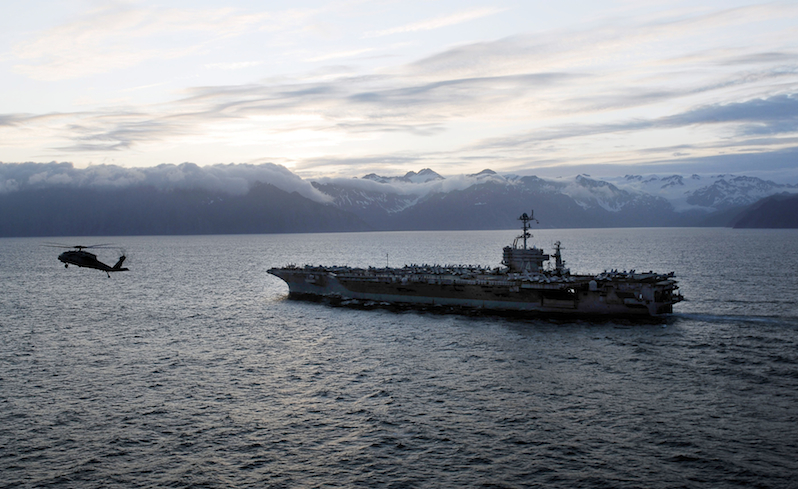 A Navy aircraft carrier and helicopter during the 2009 "Northern Edge" training exercises in the Gulf of Alaska. (Wikimedia Commons)
1
2
A Navy aircraft carrier and helicopter during the 2009 "Northern Edge" training exercises in the Gulf of Alaska. (Wikimedia Commons)
1
2
A Navy aircraft carrier and helicopter during the 2009 “Northern Edge” training exercises in the Gulf of Alaska. (Wikimedia Commons)
This essay is a joint TomDispatch/Truthout report. It’s war in the Gulf and the U.S. Navy is on hand to protect us. No, not that Gulf! I’m talking about the Gulf of Alaska and it’s actually mock war — if, that is, you don’t happen to be a fin whale or a wild salmon. This May, the Navy will again sail its warships into the Gulf of Alaska. There, they will engage in military maneuvers and possibly drop bombs, launch torpedoes and missiles, and engage in activities that stand a significant chance of poisoning those once-pristine waters, while it prepares for future battles elsewhere on the planet. Think of it as a war against wildlife, an assault on the environment and local coastal communities. And call it irony or call it American life in 2017, but the U.S. military’s Alaska Command has branded Emily Stolarcyk “a troublemaker” for insistently pointing this out. In a state where such a phrase is the equivalent of an obscenity, some have bluntly called her “anti-military.” The office of Republican Senator Lisa Murkowski has termed her a “rabble-rouser,” while a Kodiak Assembly member labeled some of what she’s been saying about the Navy “just silly.” As a resident of the tiny fishing town of Cordova, Alaska, the most radical rabble-rousing thing about Stolarcyk may be the passion with which she loves this region of the planet in all its majesty. It’s why she’s taken a fierce and unwavering stand for years now against the ongoing training exercises the Navy carries out in the Gulf of Alaska during one of the largest migrations of birds and marine life on Earth. These exercises, which inject tons of toxic materials into the Gulf and use significant explosive ordnance, are once again scheduled to take place just as Alaska’s commercial fishing season opens. Located in the state’s massive Chugach National Forest, coastal Cordova is nestled between the glacial-clad Chugach Mountains, Prince William Sound, and the Copper River. Fishing is the heart and soul of the town, as well as the foundation of its economy. A rough and tumble place, it regularly lands on lists of the top 10 American fishing ports, whether measured in pounds of fish caught annually or their value. A fish tax pays for its schools and the upkeep of most of its infrastructure. At least a quarter of its jobs are connected to the commercial fishing industry. “Without fishing, the town wouldn’t even be here,” says Stolarcyk, who knows the intricacies of the Navy’s plans better than most people in the Navy do, as we tour Cordova’s harbor. It is impossible to overstate how iconic salmon are here. “What we have in Cordova is one of the last wild places left in the world, and one of the last places on Earth where we still have healthy salmon runs,” she tells me. She’s the program director for the Eyak Preservation Council, an environmental and social-justice-oriented nonprofit based in Cordova, whose primary mission is to protect wild salmon habitat. Her partner is about to start his seventh season as a commercial fisherman. Their apartment building even has a fish smoker. “Salmon bring this town to life, you can feel the energy once the fish start returning, it’s palpable,” she explains, excitement in her voice. “You can hear the boats coming in and people go to stand on the shore to welcome them back.” However, this year, as in 2015, the Navy plans to conduct its part of Northern Edge 2017 (NE 17), a training exercise, right in her neighborhood. These war games, which occur every other year, include ships, aircraft, ordnance, and the widespread use of sonar across more than 42,000 square nautical miles of the marine environment of the Gulf of Alaska. And it is well known that sonar causes injury and death to whales, dolphin, and other marine life. It has been shown that whales will even beach themselves to escape the noise, which is more than 100 decibels louder underwater than even the loudest rock concert. Thanks to a major lawsuit against them, the Navy agreed to limit the use of certain kinds of sonar in Southern California and Hawaii, due to its impact on the endangered Blue Whale along with other species. But not in the Gulf of Alaska. Fishing for an Answer As in 2015, the Navy’s plans threaten an area of the Gulf that couldn’t be more biologically sensitive or rich in wildlife. Their training area includes a State of Alaska Marine Protected Area, a National Oceanic and Atmospheric Administration Fisheries Protected Area, and both the Gulf of Alaska Seamount Protected and Slope Habitat Conservation areas. Nevertheless, the Navy is requesting permits to use live ordnance including bombs, missiles, and torpedoes, along with active and passive sonar in “realistic” war-training exercises that could release as much as 352,000 pounds of “expended materials” into those waters including, according to the Navy’s own Environmental Impact Statement (EIS), missiles, bombs, and torpedoes. These waters support some of the most valuable fisheries left in the United States and the commercial fishing industry is the single largest private sector employer in the state of Alaska, providing over 63,000 jobs. Nevertheless, the Navy’s own EIS claims that fish in the area are at risk of chemical exposures of various sorts because the war games will introduce chromium, lead, tungsten, nickel, cadmium, cyanide, and ammonium perchlorate, along with numerous other heavy metals and toxic substances, into Alaskan waters. According to the EIS, “Little is known about the very important issues of nonmortality damage in the short and long-term, and nothing is known about the effects on behaviour of fish.” It adds that “potential effects” include “death or damage” and that “fish not killed or driven from a location by an explosion might change their behavior, feeding pattern, or distribution.” While the Navy itself is aware of some of the damaging impacts of its exercises, others remain unknown and that service is making no effort to learn what they might be. The precautionary principle of do no harm is clearly not operative here. The Navy’s EIS does estimate that, during the years in which these war games are to be conducted, there will be more than 182,000 “takes” — direct deaths of marine mammals or disruptions of their essential behaviors like breeding, nursing, or surfacing. On fish deaths, it offers no estimates at all. A partial list of affected species includes blue, fin, gray, humpback, minke, sei, sperm, and killer whales, the highly endangered North Pacific right whale (of which there are only about 30 left), as well as dolphins and sea lions. No fewer than a dozen native tribes including the Eskimo, Eyak, Athabascan, Tlingit, Sun’aq, and Aleut rely on the area for subsistence living, not to speak of their cultural and spiritual identities. As the May 1st launching day for NE 17 looms, we already have at least some inkling of just what kinds of damage might result. Immediately following Northern Edge 15, Alaska witnessed the single largest whale mortality event ever to occur in its waters. Eighteen carcasses of endangered whales were found floating near Kodiak Island within the area in which the Navy had conducted its exercises, attracting national media attention. Statewide, in the year that followed, Alaska had its worst pink salmon fishing season in four decades. A federal disaster declaration was even issued to give salmon fishermen some relief, deferring the repayment of loans. That year also saw the biggest die off of Murres, a small seabird, ever recorded in the state. Human-caused climate disruption impacts had long been noted across the North Pacific, whose climate-change-affected waters were warming to record temperatures that year. While this obviously played a role in such events, what impact the naval exercises had across the Gulf of Alaska remains largely unknown, in part because the Navy refused in 2015 — as it will again this year — to allow independent observers on its ships or to conduct follow-up studies focused on how their war games impacted the environment and marine life. Local opposition is strong, as ten Alaskan communities have passed resolutions requesting that the Navy move the timing and location of Northern Edge 2017 and all future training events to the fall or winter months and further offshore to minimize their impact on fisheries and migrations. Furthermore, the mayors of Cordova, Girdwood, Tenakee Springs, and Valdez sent letters to Senator Murkowski, requesting that she ask the Navy to relocate NE 17. The senator, hardly a critic of the military, nonetheless wrote the secretary of the Navy last September to “express concern over the manner in which the Navy is approaching its participation in Northern Edge 2017,” and called a lack of naval public affairs guidance “extremely troubling.” Assistant Secretary of the Navy Dennis McGinn replied, “I readily admit we could have done a better job reaching out to potentially affected stakeholders leading up to NE 15.” Stolarcyk is truly a David going up against the naval Goliath. Her dedication to this region of the planet has been and continues to be unwavering. “How could you live in this place and experience all this beauty and not get how precious this is,” she asks with typical intensity as we walk near her town’s harbor and bald eagles soar above us. “I love this place so much, and I can’t even let myself feel all my emotions when I’m working on this issue, because I wouldn’t be able to function.” The late afternoon sun is just beginning to hint at the evening to come as she stares out into the waters of the Gulf, takes several deep breaths, and says, “We have to defend our lifestyle here, because if we don’t do it, who else is going to do it? If the Navy destroys the Gulf of Alaska, they can just leave, while we’re the ones who have to live with whatever is left.” “The Navy Is Getting Away With Murder” My trip to Alaska to report on the upcoming war games began in the small ski town of Girdwood, a 40-minute drive east of Anchorage. There, Stolarcyk and I met up with her colleague, Christina Hendrickson, as they continued their efforts to push the Navy’s schedule for the war games out of prime wildlife season. Hendrickson, who specializes in environmental law, is a former defense contractor. Like two high-octane lawyers before a big trial, she and Stolarcyk instantly begin talking a mile a minute about what their next moves should be. They bring me up to speed on the latest Navy maneuvers in what is now a publicity war over Northern Edge 17 and the way its officials have officially opted to “work with the stakeholders.” On the other hand, as Hendrickson points out to me, “they have refused to meet with Emily and myself” — and, as it happened at that point, me, too. I’d recently contacted Captain Anastasia Schmidt, director of public affairs for Alaska Command in Anchorage, to arrange a meeting and my request had been denied. Unfortunately, as Hendrickson points out, the permits the Navy requested from both the National Oceanic and Atmospheric Administration and the National Marine Fisheries Service allow them to war game their hearts out in the Gulf for the next five years without taking the slightest responsibility for analyzing the potential impact of their actions or dealing with the myriad species migrating through the area during the training period. While those who fish here must adhere to environmental standards, the Navy doesn’t have to. “Imagine that you have a friend who is a subsistence fisherman,” Hendrickson says, “who is looking at his nets each season, and on the seasons the Navy trains, there seems to be less fish in them, and there are less whales returning, and then there’s a huge Murre die off. There are sick sea otters or sea otters not returning at all. It’s obvious to me that the Navy is not connecting these dots.” I ask her what exactly drives her on this issue and she stares out the window at the still snow-covered trees, then looks me dead in the eyes and says, “The Navy is getting away with murder and that upsets me.” “If It Walks, Swims, or Crawls, I’ve Fished It” Stolarcyk and I fly on to Kodiak Island where we meet up with Tom Lance, the natural resources director for the Sun’aq tribe. We’re there so that the two of them can make a presentation to the island’s Borough Assembly in hopes of inspiring another Alaskan community to pass a resolution against the timing of the exercises. Lance and I sit down in a café on the outskirts of town and he immediately begins describing the massive whale carcasses floating in the Gulf of Alaska after Northern Edge 15, many of which washed ashore on Kodiak. As he points out, just before those war games began, the Sun’aq and Afognak tribes “admonished the DOD [Department of Defense] for not respecting their people and their resources, and demanded that NE 15 not take place. The Navy told the tribal council representatives, basically, ‘thank you.'” After essentially being blown off, the tribes requested another meeting, which only happened after the exercises were over. At that time, they insisted that the Navy change the season for the next set of exercises to late fall or winter and the location as well. “Another condition was for them to account for fish take [that is, the disturbance or destruction of fish populations], as if it were a commercial fishing operation where they are given a total allowable catch. To this they responded that they don’t harvest fish, so why should they have to track that?” Your support matters…Independent journalism is under threat and overshadowed by heavily funded mainstream media.
You can help level the playing field. Become a member.
Your tax-deductible contribution keeps us digging beneath the headlines to give you thought-provoking, investigative reporting and analysis that unearths what's really happening- without compromise.
Give today to support our courageous, independent journalists.

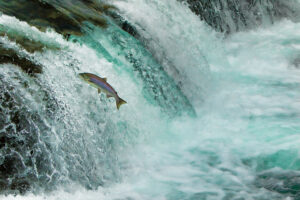
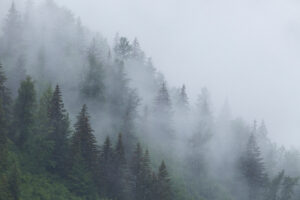
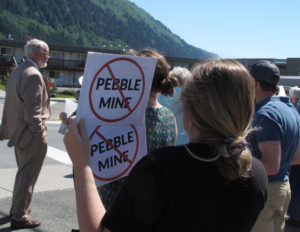

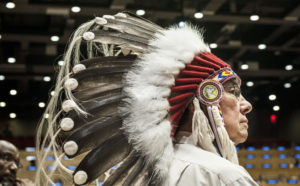

You need to be a supporter to comment.
There are currently no responses to this article.
Be the first to respond.